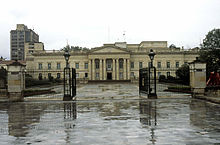- Government of Colombia
-
Colombia 
This article is part of the series:
Politics and government of
ColombiaConstitutionLegislatureExecutiveElectionsDivisions- Major parties
- Liberal Party
- Conservative Party
- Social Party of National Unity
- Radical Change Party
- Alternative Democratic Pole
- Green Party
- MIRA
Related issues
The government of Colombia is a republic with separation of powers into executive, judicial and legislative branches. Its legislature has a congress, its judiciary has a supreme court, and its executive branch has a president.
The citizens of Colombia cast votes concerning their government, and they employ a public sector office for an inspector general to oversee the public interface of the government. This safeguards the public, and guarantee the human rights spelled out in the Colombian Constitution of 1991, which provides the framework for a welfare state and a unitary republic.
Colombia has " control institutions" which mix government and public officials, who work alongside one another. For example, the public's inspector general works closely with the government's controller general whose job it is to ensure governmental fiscal responsibility. An independent Ombudsman deals with maladministration complaints and functions as the national human rights institution.
Executive
 Casa de Nariño, the presidential palace in Bogotá houses the President of Colombia and maximum representative of the Executive Branch of Colombia.
Casa de Nariño, the presidential palace in Bogotá houses the President of Colombia and maximum representative of the Executive Branch of Colombia.
The executive branch of power in Colombia is headed by the President of the republic. He is supported by the Vice President of Colombia, the ministries of Colombia. and Administrative Departments of Colombia. The government is in charge of creating and developing politics intended to Colombia the governors of the Departments of Colombia are elected through popular vote to represent the president and the executive branch of government at a provincial level.
Majors are subsequent to the governors, as maximum representatives of the executive branch of government at a municipal level. Majors are also elected in regional elections along governors of departments.
External links
- (Spanish) Government of Colombia official website
Governments of South America Sovereign states Dependencies and
other territories- Aruba
- Bonaire
- Curaçao
- Falkland Islands
- French Guiana
This Colombia-related article is a stub. You can help Wikipedia by expanding it. Colombia is also working to expand its government to be more like ther French government they say
Categories:- Government of Colombia
- Colombia stubs
Wikimedia Foundation. 2010.
Look at other dictionaries:
Colombia–Venezuela relations — Colombia … Wikipedia
Colombia — • Forms the north west corner of the South American Continent Catholic Encyclopedia. Kevin Knight. 2006. Colombia Colombia † … Catholic encyclopedia
Colombia Always — Colombia This article is part of the series: Politics and government of Colombia … Wikipedia
Colombia Unite — Colombia This article is part of the series: Politics and government of Colombia … Wikipedia
Colombia — Colombian, adj., n. /keuh lum bee euh/; Sp. /kaw lawm byah/, n. a republic in NW South America. 37,418,290; 439,828 sq. mi. (1,139,155 sq. km). Cap.: Bogotá. * * * Colombia Introduction Colombia Background: Colombia was one of the three countries … Universalium
Colombia — This article is about the country. For other uses and spellings, see Colombia (disambiguation) and Colombia (disambiguation). Republic of Colombia República de Colombia (Spanish) … Wikipedia
Colombia–United States relations — United States – Colombia relations Colombia … Wikipedia
Colombia in popular culture — The depiction of Colombia in popular culture, especially the portrayal of Colombian people in film and fiction, has been asserted by Colombian organizations and government to be largely negative and has raised concerns that it reinforces, or even … Wikipedia
Colombia Three — A Sinn Féin poster calling for the men s release The Colombia Three are three individuals – Niall Connolly, James Monaghan and Martin McCauley – who are currently living in the Republic of Ireland, having fled from Colombia, where they were… … Wikipedia
Government entities of Colombia — The Government entities of Colombia ( es. Entidades Gubernamentales de Colombia) are entities of the government of Colombia. The government entities is made up by commissions, control agencies, administrative departments, directorates, funds,… … Wikipedia
- Major parties
